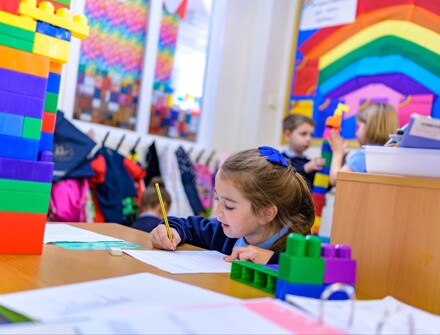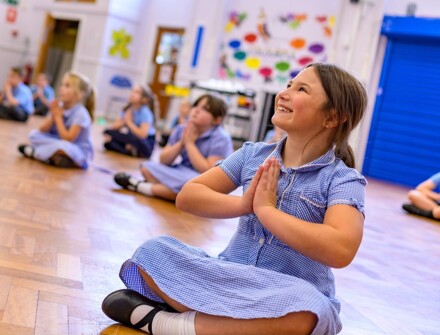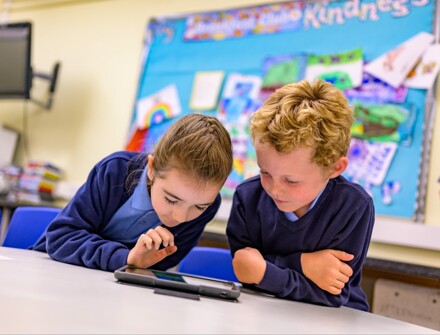Our Nursery
- Home
- About Us
- Our School Values
Our School Values
Love, Joy, Peace, Kindness
Our school vision and values are at the core of everything we do. They underpin our teaching and learning, and provide an environment which prepares our pupils as confident, happy citizens.
“Nurturing minds. Fulfilling lives.”
“Neither the sower or the seed change the ground. The ground is what it is. Be the seed that grows on good soil"
Luke 8-15
We want all our children to know that God is with them and will continue to be throughout their lives. The bible tells us that when we draw close to God he equips us with the fruit of his spirit Galatians 5:22 including Love, Joy, Peace and Kindness. Within a school context we believe Nurturing Minds, Fulfilling Lives expresses our core vision for education and we use the Parable of the seeds to illustrate this. Mark 4:1-20
Philippians 4:8 reminds us “Whatever is true, whatever is noble, whatever is right, whatever is pure, whatever is lovely, whatever is admirable — if anything is excellent or praiseworthy — think about such things and the God of peace will be with you” this links to our understanding of the importance of developing a positive metacognitive script that helps us to continue to grow through life.
John 10:10b outlines Jesus’ intention for us all to live a life in all its fullness and our curriculum aims to broaden children’s experience and deepen their skills and abilities in order to do this. We recognise that for many life is tough and to experience success sometimes things don’t come easily. We value the importance of forgiveness (both the willingness to forgive and accept forgiveness) yet, at the same time, recognise that it is not a tidy concept; it does not mean forgetting. We look to the Japanese art of kintsugi ("golden joinery"), also known as kintsukuroi ("golden repair"), to model this to our community: it shows us that even our scars can be made beautiful and useful. The image of kintsugi allows us to see forgiveness in a different way. When something is repaired using kintsugi, the “injury” or the cracks do not in any way disappear. If anything, they are highlighted by the lines of gold. The scars become a part of the story of the object, but they are no longer sharp, painful places of damage. Our mistakes and experiences are opportunities to learn and grow: nurturing minds, fulfilling lives. Children are reminded that just like seeds they need to be careful to be rooted in fertile soil if they are to flourish and that they have responsibility to make good choices to support this. As a school we aim to ensure that our school environment is as fertile as possible so that even our most vulnerable pupils are able to flourish.
An extension of our vision are our learning attitudes: Creativity, Spirituality, Responsibility and Aspiration, these further define all that we do.
School Mission Statement
God is with us on our journey together as we become the best learners we can be, nurture a safe and welcoming school for all, placing worship at the heart of all we do.
What is spirituality?
Spirituality is the way in which we combine our thoughts and emotions to reflect, respond to, and seek to give meaning and purpose to the experiences that we encounter in life.
The windows, mirrors, doors analogy clarifies this meaning.
We gaze out through windows onto the world, responding with our emotions and trying to make sense of what we see. We use mirrors to reflect on our thoughts and feelings, and how what we see through the window connects with our inner selves, and how we connect with what we see and understand. This becomes a spiritual experience when it transforms us and so we walk out through the door into life differently from before. For some, this spiritual experience leads to a sense of transcendence: in other words a feeling or belief that something exists beyond what can be directly seen. Christians would describe this state as God.
Pupils’ spiritual development is shown through their:
- Beliefs, religious or otherwise, which inform their perspective on life and their interest in and respect for different people’s feelings and values
- Sense of enjoyment and fascination in learning about themselves, others and the world around them, including the intangible
- Use of imagination and creativity in their learning
- Willingness to reflect on their experiences
Why is spiritual development important?
As a church school we believe that our role is to educate the whole child and that the spiritual growth of our children is as important as, and indeed is a vital contributor to, their academic development. The themes developed each week through our assemblies, our school vision, as well as opportunities woven throughout our curriculum underpin all we seek to achieve in the lives of our children. Getting people to consider the world around them, reflecting and thinking for themselves, evoking positive emotional responses and pondering ultimate questions is the integral ingredient in our recipe for spiritual development.
Collective Worship provides opportunities for:
- Reflection and response
- Thinking deeply and drawing links between ideas
- Stillness and prayer
- The respect of personal and collective beliefs
- Sharing and celebrating common beliefs
- Celebrating success and talent
- Sharing happiness, sorrow, hurt, excitement, anticipation, fear, etc.
- Shared activities such as singing, listening, laughing, reflecting on a theme
- Remembering and celebrating the lives of people of spiritual significance
- Emphasizing common purpose and values
- Experiencing emotions
- Taking part with sincerity and a sense of higher purpose
- Through pupil-led worship, children have opportunity to support the spiritual development of others, that in turn leads to a sense of fulfilment and is therefore a spiritual experience for the young leaders
- Creative responses to experience such as music, drama, poetry, story
- The use of visual stimulus such as religious symbols, candles, art, icons, photos, video
Religious Education is a subject that looks at the spiritual experiences of others and how these change and shape their lives. RE allows children to use what they find out about other people and their beliefs to reflect on their own experiences. Through this process, children can engage with ultimate questions of meaning and purpose and begin to shape their own beliefs. RE allows children to engage with the idea of mystery and questions with no clear answers.
The wider curriculum also provides opportunities for spiritual development. The school’s planning format indicates where the children’s learning will provide opportunities for spiritual reflection.
In Physical Education:
- Being a team member.
- Pushing yourself to the limits.
- Extremes of skill, endurance and achievement.
- Emotion in sport such as those evoked through success and failure
- Personal limitation and acceptance that others may perform better
- Appreciation of perfection.
- Sportsmanship.
In Design and Technology:
- Discovering how something works.
- Appreciating ingenuity.
- Beauty in design.
- Perseverance to solve problems.
- Personal achievement.
- Learning from others and nature.
In Literacy:
- Empathy with authors and the characters in stories and plays.
- The appreciation of beauty in language.
- Emotions and sentiments in writing and speech.
- The values of great works.
- Heroes and heroines in literature.
- The reading and writing of poetry.
- Imagining oneself as someone else.
- Escaping into other worlds through literature.
- The element of wonder in literature.
- Pleasure derived from the creative process.
In Numeracy:
- Infinity and nothing.
- Pattern and order.
- Shape and regularity.
- Truth, certainty and likelihood.
- The universality of mathematics over time and space.
- The wonder of numbers, formulae and equations.
In Science:
- Wonder as the basis of science.
- Questions of beginning, creation and evolution.
- Discovering the limits of experimentation.
- Birth, life, death and renewal.
- The universe and beyond.
- Regularity and order in science.
- Beliefs in science and the faith of scientists.
- The impact of scientific achievements.
In ICT:
- The wonder of worldwide instant communication.
- The speed of the growth of knowledge.
- The accessibility of knowledge and contact with other people worldwide.
In the Creative Arts (Art, Music, Drama and Dance):
- The work of creative artists from a variety of times and places.
- Beauty, truth and goodness.
- Expressing, interpreting and exploring deep feelings and profound beliefs.
- Artistic creativity.
- The effects of the arts on emotions and senses.
- The arts as means of expressing mood.
- Skill in creation and performance, and particularly in personal reflection upon their own creativity using various art forms.
- Effects on the emotions and senses.
- Personal response and preference.
- Mood.
- Skill.
- Pattern.
- Formulae.
- The sense of fulfilment and transcendence through performance.
In Geography:
- Wonder at the diversity of environments and people.
- Questions about the care of the environment.
- The beliefs behind particular causes and campaigns.
- World (economic) development.
- Land formation.
- Empathy with people from other parts of the world. In History:
- Being in touch with past people, things and ideas.
- Being part of history.
- Handling artefacts.
- Influential events and people.
- The commitment of significant people in history.
- War and peace.
- Interpretation in history.
- The nature and importance of invention and exploration.
- Empathy with people from other times in history.



